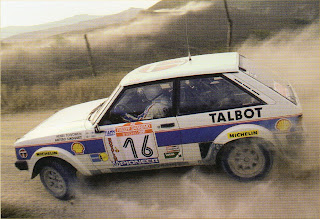
Having just crowned its first World Champion rallying entered the 1980s on a high. Alas, it was to be a false dawn and the next two seasons, although interesting in their own way, were a bit of a disappointment.
Firstly the Fiat/Ford rivalry appeared to be over for the time being: a new front wheel drive Escort had been launched and so Boreham retired from competition and went away to devise a new rear wheel drive, turbocharged device based on the new Mark three bodyshell.
Secondly the end was now nigh for the old Groups 1 to 4, set to be replaced in 1982 by the news Groups A and B (no group N yet). This meant that most manufacturers decided to keep their powder dry and wait to see ow things went. The exception though were Renault and Audi. The French team unleashed its pocket rocket 5 Turbo on the Tour de France and in Corsica it looked like it was going to win by a country mile before mechanical gremlins handed the victory to a geriatric Porsche. Audi meanwhile were planning a quiet revolution, but at this stage no one took them seriously.
On the plus side the cars were looking better and rallying was promoting itself better. Rothmans, who were running Escorts prepared by David Sutton had inherited Ari Vatanen and Hannu Mikkola and fielded aggressively striped cars and an aggressive marketing campaign. Unfortunately an excess of aggression by their drivers limited their success - in Portugal their cars actually ended up piled on top of each other when both left the road in the same spot.

Fiat had resprayed the 131 in a similarly rakish manner and the old car didn't let them down again. Rohrl's victory on the Monte, the first by a conventional car for as long as anyone can could remember, set them off in grand style. Rohrl then convincingly blew his team mate Alen away again in Portugal and suddenly Fiat, who had only been aiming for a few cameo appearances during the season, were suddenly groping around for enough lira to make a championship bid. They eventually made it look easy, but it was a fairly shoe string affair.

A new round for the year was Argentina. The rally was a worthy successor to the great road races of the fifties in which Fangio had first made his name. Nobody knew whether it would be an Africa-style endurance rally or a European type sprint event, so the entry was fairly varied. The big Peugeot's and Mercedes looked great in their slick tired for the long fast tarmac stages, but the fast stages shredded their tires and the sprint cars dominated with Rohrl taking the honours.

Alen showed he was still the top Finn by taking victory on the 1000 lakes, but industrial action meant Rohrl had to tackle the gravel stages of the Sanremo in a tarmac car with no under body protection and extremely minimalist service back up in New Zealand saw a cautious Rohrl beaten into second by Salonen's Group 2 Datsun. The title was wrapped up by another cautious drive in Corsica Fiat retired bankrupt and missed the RAC completely for the first time ever.
Apart from the Rothmans Fords the only sustained opposition was from Opel with their new Ascona 400, who took the Swedish and showed promising form on the RAC, Talbot who fielded Group 2 Sunbeam Lotuses for Guy Frequline and Henri Toivonen, and Mercedes. The Germans were taking their big cars out of Africa for the first time but the results were disappointing.
Elsewhere there were signs that the old order was changing. Darniche's Stratos was beaten into second on the Monte, Blomqvist's Saab likewise in Sweden whilst the might of Mercedes lost to Datsun on the Safari. But the real revolution was still waiting in Stuttgart. When Hannu Mikkola first told people he'd signed for Audi they couldn't have been more amazed if he'd said Trabant. However when a Quattro used as the course opening car on the French 1000 Pistes rally set times that would have seen it win by several minutes if it had been allowed to enter, people started to take notice.
But the Quattro revolution was for next year. 1980 belonged to a German driver not a German car: Walter Rohrl, the laid back German who never quite fitted in at Fiat. His debut in a 131 had seen him leave the road at high speed in a tarmac car with only half a roll cage. He had a lucky escape and the Italian's laid back approach to driver safety was always something that concerned him. The Sebastian Loeb of his era, Rohrl would drive the stages in his head the night before a rally, checking his times on a stop watch. Blessed with superhuman reactions, he would have his cars set up to understeer like racing cars, relying on the handbrake and his reflexes to get him out of trouble.

But whilst it was Germany's year, it was two young Finns who were attracting the attention as the season ended. Toivonen was the talk of the town, but his talent was to prove somewhat Mercurial. Ari Vatanen on the other hand was a driver who started his career driving at 110% and slowly crashed his way down to a level where he could actually finish a rally. In 1980 he collected his second British Open Championship, but he also won his first World Rally in Greece. His team mate Mikkola had once said that when Vatanen starts winning nothing would stop him. In 1981 we'd find out if that was true.




No comments:
Post a Comment